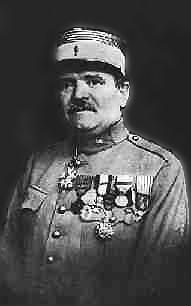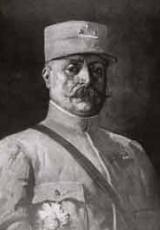Sylvain Raynal

Sylvain Eugène Raynal was born on the 3rd March 1867 into a protestant family of artisans from Bordeaux, from whom he inherited his work ethic and deep patriotism. He enrolled at the school of Saint-Maixent, after an education at the high school in Angoulême, which he left with the same (thirteenth) grade as when he arrived. He then went on to serve in a garrison. Posted to headquarters in Paris, he served under Guillaumat and was then posted to Algeria with the 7th regiment of tirailleurs in Constantine, where he learned that France had entered into the war in the summer of 1914. He was wounded in the shoulder by a machine gun bullet in September 1914 and following the bombardment of his command post in the December he spent ten months in hospital before returning to action on the 1st October 1915. At the end of 1915, the German offensive focussed on the Verdun sector under the command of the Kronprinz, the oldest son of the Kaiser. A 300 day long stand-off followed, which would give birth to a contemporary military movement: Bois des Caures, Froideterre, Mort-Homme, Douaumont, Fleury, etc. and Vaux. On the 4th March 1916, German High Command gave the order to scale down the deadlock at Verdun and push on to Paris.
An advanced outpost, the Fort de Vaux was defended by the 300 remaining men of the 142nd infantry regiment commanded by Raynal of the 96th R.I. He had volunteered to serve at Verdun, despite just finishing his convalescence after sustaining shrapnel wounds, which earned him a promotion to Officer of the Légion d'honneur. Between the 2nd and 7th June 1916 Commander Sylvain Eugène Raynal held out with his men against the German attacks of the 39th infantry regiment. "Heroism is sometimes born from the most humble background" (Fleuriot de Langle, in Le Ruban Rouge (The Red Ribbon))... Completely cut off, on the 4th June he sent his last carrier pigeon, "Vaillant" (registration number 787-15) carrying the following message: "We are still holding out, but are subject to attacks of gas and highly dangerous fumes; it is urgent that we get out of here. Please send us a visual signal via Souville, as they are not responding to our calls. This is my last pigeon. Raynal." Having received no reply, with no drinking water remaining and unable to see how their position could be relieved by reinforcements, the commander and his men finally surrendered. Brought before the Kronprinz, he held out a bayonet belonging to an ordinary soldier to the crown prince, as his sword could not be found in the ruins of the fort, saying to him: "Prince, this weapon is worth an officer's sword". The Prince would inform him, following the interception of a message from the French High Command, that he had been awarded the red cravat of the Légion d'Honneur., Having accomplished its mission, his messenger was to receive the award of the ring of honour - the Post Office Museum in Paris still has its body to this day. As a prisoner Raynal was detained in Mayence from the 11th June 1916 until November 1917 and then for 3 months in Stressburg on the Polish border in Eastern Prussia and finally in Interlaken in Switzerland from the 30th March 1918 until his release on the 4th November. After the war Sylvain Eugène Raynal retired to 36 rue Denfert-Rochereau in Boulogne-Billancourt (Hauts-de-Seine département) where he would live until his death on the 13th January 1939. A plaque was mounted there in 1966 on the fiftieth anniversary of the Battle of Verdun.


